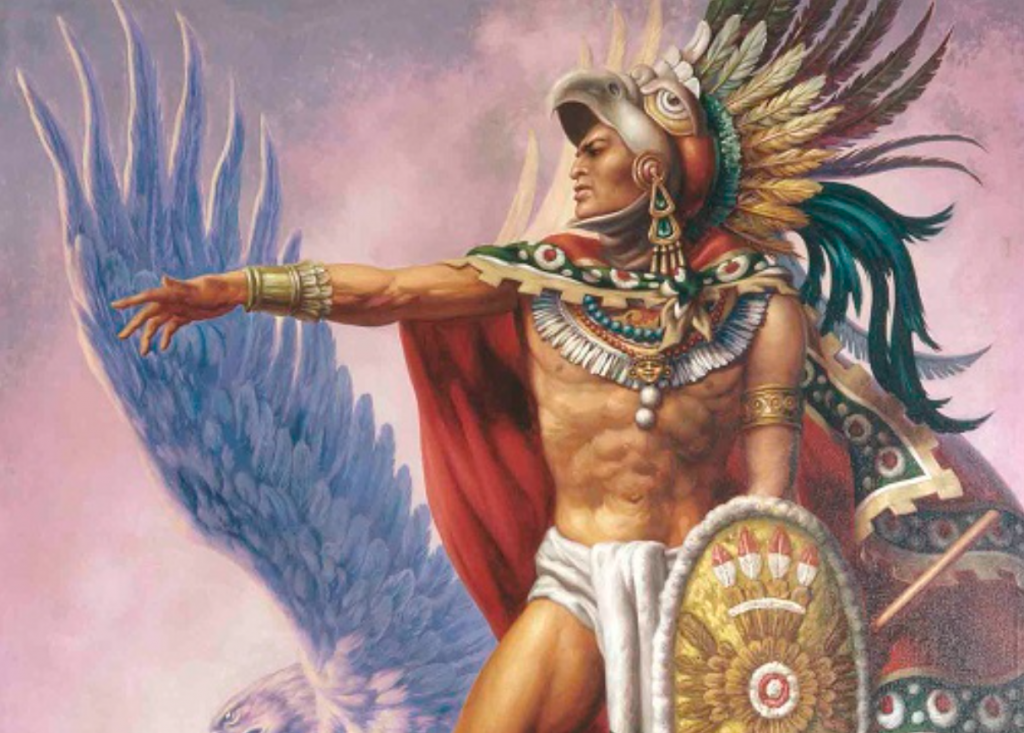Cuauhtémoc, although murdered in defeat, left a legacy as the last Aztec emperor who led Tenochtitlan in defense against Hernán Cortés and the Spanish invaders. The young warrior was initially selected to serve as emperor because of his fierce opposition to the Spanish invasion, which greatly appealed to the majority of the empire. Moctezuma II, who reigned during the first invasions of the Spanish, lost the support of his people, whereupon they publicly executed him for submitting and complying with the Spaniards.1 Moctezuma’s successor, Cuitlahuac, attempted a united resistance against the colonizers, but proved unsuccessful following his unexpected smallpox-related death only eighty days after beginning his reign.2 The last and final tlatoani, or emperor, was the young and vigorous Cuauhtémoc, whose assumption of power was supported by a political motivation to organize against the Spanish. Having been related to the past two tlatoani, holding significant connections to the neighboring Mexica district of Tlatelolco, his fierce and public opposition to the Spanish, and continuing the resistance against the colonizers laid by his predecessor Cuitlahuac, provided promise and assurance of Aztec survival. These characteristics made young Cuauhtémoc the obvious choice among the highest noblemen, and so he became selected to lead Tenochtitlan in 1520.3 Although the young tlatoani had promising factors working in his favor, the Spanish forces prevailed, leading to the recognition of Cuauhtémoc as the last Aztec emperor. What followed was the colonization of the Aztec people that would transform the Mexica area forever.

Cuauhtémoc’s predecessor, Cuitlahuac, had spent his eighty-day reign defending the empire from Hernán Cortés, and proved unsuccessful except for a minor victory where he drove out the Spaniards on the Noche Triste in July of 1520.4 Amid the death of Cuitlahuac and the inauguration of Cuauhtémoc, Cortés strategized an attack against Cuauhtémoc’s Tenochtitlan in response to the Spanish Night of Sadness. As part of his militaristic plan, Cortés captured the smaller neighboring city Tlaxcala, where he forced its people to aid in the upcoming destruction of the Aztec capital Tenochtitlan.5 Dramatically denying Cortés’ offer to surrender, Cuauhtémoc issued a decree to sacrifice all those who sympathized with the Spanish, especially those who converted to Christianity, to the Aztec gods as a jab to Cortés’ presence and as a threat to any of his people who would dare aid in Cortés’ conquest.6 The first attack on Tenochtitlan came in March 1521, where Cortés had taken control of a nearby valley, the Valley of Mexico, and was able to gain alarming ground until Cuauhtémoc met the Spanish forces with his own forces. Deploying his land and naval forces, Cuauhtémoc pushed back and interrupted Cortés and his indigenous allies.7 However, this small victory was not enough to completely remove the Spaniard and Tlaxcala armies from the periphery of Tenochtitlan. After retreating back through the Valley of Mexico, Cortés quickly received reinforcements from Hispaniola, and once again held the upper hand in the back-and-forth war with the Aztec tlatoani. Only a month later, Cortés penetrated himself into the borders of Tenochtitlan, where Cuauhtémoc was left vulnerable and desperate. The years of military preparation, heroic legacy, and the royal bloodline of Cuauhtémoc were desperately called on in these moments of siege, in order to protect his people. As Cortés’ forces were inching closer and closer to the streets of the capital, Cuauhtémoc directed his warriors in the same direction. Knowing that the Spanish had militaristic advantages, such as a cavalry force, the tlatoani depended on his soldiers’ knowledge of the intricate grounds of Tenochtitlan, providing a temporary success when the Spanish were forced to retreat and leave the capital.8 To no surprise, Cortés met Cuauhtémoc’s advances with his own and delivered a detrimental blow by seizing Aztec food supplies and brutally starved the city until the tlatoani responded with his own move.9 In a final unified attempt, Cuauhtemoc called on his Mexica neighbors to aid in the fight against the white man that had continued for almost three months.10 At this point, Hernán Cortés had conquered much of the Mexica region, leaving only Cuauhtémoc’s earliest ally, Tlatelolco, as reinforcements.11 The tlatoani was out of militaristic strategies and was edging toward defeat. While most of his Tenochca people began fleeing to Tlatelolco, he marked the end of his war against the Spaniards by attempting to flee his city, but was ultimately captured by his enemy.12 Upon his capture, Cuauhtémoc requested to be killed at the hands of Hernán Cortés, which could have been an act to save his honor or to please the Aztec gods, but Cortés refused and cited his country’s respect for bravery and valor, even in an enemy.13 The mercy from Cortes was short-lived and ended when it came time to question Cuauhtémoc about the riches and resources of his empire. Facing torture, Cuauhtémoc remained quiet and restricted when interrogated about the gold rumored to be hidden in the Tenochtitlan empire. Cortés responded to the captured emperor’s silence by gruesomely burning the soles of his feet to invoke a break of information. While Cortés committed acts of terror in the name of greed and hegemony, Cuauhtemoc remained loyal and sacrificial for the sake of his empire and its riches.14 One could say he remained enduring because of his commitment to the Aztec gods and his adversary to the long-hated Spanish colonials. This encounter of punishment and persecution would be one of the last moments Cuauhtémoc would experience in his Mexica home before he was imprisoned by Spanish officials and stripped of his power.

Following the capture and torture of the emperor, Cortés forced Cuauhtémoc to serve under his command in exchange for his life. By 1525, Cuauhtémoc was brought along in Cortés’ expedition to Honduras, and there is debate on whether he was regarded as a Spanish soldier or as a Spanish slave.15 Since Cortés had expressed concern about the possibilities of Cuauhtémoc leading a revolt in his absence, it is easier to believe the latter on Cuauhtemoc’s status. The relationship between Cuauhtémoc and Hernán Cortés was passive-aggressive, to say the least, because of Cortés’ attempts at mercy that would be met almost immediately with reprimands against the emperor. For example, Cortés agreed to allow the defeated people of Tenochtitlan to leave the city after the capture of the emperor. Although they left physically unharmed, Cortés left them psychologically crippled when he forcibly converted Cuauhtémoc to Christianity and undermined their relationship to Huitzilopochtli, the Aztec god. Cortés gave Cuauhtémoc a quasi-credible status when he baptized him into Christianity, calling him the Christian name Fernando Cuauhtémotzín, but reminded him of his powerlessness by allowing the tlatoani to keep the title but hold absolutely no reign over his own people.16 Although beaten, captured, and patronized, Cuauhtémoc did not accept complete defeat and remained determined throughout the Spanish expedition to Honduras. Cuauhtémoc, along with other captured noble Aztecs, plotted to assassinate Cortés mid-expedition as an attempt to tip the power back in the Aztecs’ favor. Betrayed by one of their own, a member of the Mexica people informed Cortés about the plot to assassinate him. After heavy interrogation and remembrances of his burning torture years earlier, Cuauhtémoc and his allies were condemned to death for their acts against Cortés. In an account provided by Spaniard Bernal Diaz de Castillo, who worked closely under Cortes, Cuauhtemoc shouted his last words to the conquistador:
Now I understand your false promises and the kind of death you have had in store for me. For you are killing me unjustly. May God demand justice from you, as it was taken from me when I entrusted myself to you in my city of Tenochtitlan! 17
Signifying the ultimate end of the great Aztec empire, Cuauhtémoc was hung alongside a fellow nobleman for planning to assassinate a Spanish official. In Diaz del Castillo’s accounts, Cortés felt overwhelming guilt for executing the Aztec man who was deeply revered even in bondage.18

Perhaps questioning the treatment he gave the emperor, the colonization of a whole people, the undeserving death of the tlatoani, or all of these factors made Cortés suffer from mental and health problems following Cuauhtémoc’s hanging.19 The name Cuauhtémoc, meaning descending eagle in Nahuatl, provided duality to the tlatoani in his lifetime. He began as a young emperor whose tactics and military persona mirrored an eagle plummeting to the ground to attack and capture its prey. His life ended and his namesake symbolized the death he endured like an eagle sinking to the floor after being brought to death abruptly mid-flight. While the majority of his life was centered around the tumultuous and emotional fight to protect the Aztec and Mexica people, his death marked a significant turning point for the nation and its future. Although the Aztec empire continued after the death of Cuauhtémoc, the few and insignificant years were no match for the ultimate and complete colonization of the Spanish.
The end of the noble tlatoani Cuauhtémoc of Tenochtitlan marked the end of his great empire and the beginning of Spanish imperialism that would change the Mexica people and their country forever. Revered in life and in death, Cuauhtémoc has remained a symbol of indigenous power and honor in today’s Mexico.

- Encyclopaedia Britannica, 1998, s.v. “Cuauhtemoc.” ↵
- Domingo de San Anton Munon, Chimalpahin, Codex Chimalpahin: vol 1 Society and Politics in Mexico Tenochtitlan (University of Oklahoma Press, 1997), 56-57. ↵
- The Oxford Encyclopedia of Mesoamerican Cultures, 2001, s.v. “Cuauhtemoc” by Miguel Leon-Portilla. ↵
- Bernal Diaz del Castilo, Historia verdadera de la conquista de la Nueva Espana (Penguin Books, 1963), 234. ↵
- Bernal Diaz del Castillo, Historia verdadera de la conquista de la Nueva Espana (Penguin Books, 1963), 303-305. ↵
- Jim Tuck, “Cuauhtemoc: winner in defeat (1495-1525)” MexConnect, October 9, 2008, https://www.mexconnect.com/articles/260-cuauhtemoc-winner-in-defeat-1495-1525/ ↵
- Jim Tuck, “Cuauhtemoc: winner in defeat (1495-1525)” MexConnect, October 9, 2008, https://www.mexconnect.com/articles/260-cuauhtemoc-winner-in-defeat-1495-1525/. ↵
- Jim Tuck, “Cuauhtemoc: winner in defeat (1495-1525)” MexConnect, October 9, 2008, https://www.mexconnect.com/articles/260-cuauhtemoc-winner-in-defeat-1495-1525/ . ↵
- Jim Tuck, “Cuauhtemoc: winner in defeat (1495-1525),” MexConnect (website), October 9, 2008, https://www.mexconnect.com/articles/260-cuauhtemoc-winner-in-defeat-1495-1525/ ↵
- The Oxford Encyclopedia of Mesoamerican Cultures, 2001, s.v. “Cuauhtemoc” by Miguel Leon-Portilla. ↵
- The Oxford Encyclopedia of Mesoamerican Cultures, 2001, s.v. “Cuauhtemoc” by Miguel Leon-Portilla. ↵
- Bernal Diaz del Castillo, Historia verdadera de la conquista de la Nueva Espana (Penguin Books, 1963), 395-404. ↵
- Bernal Diaz del Castillo, Historia verdadera de la conquista de la Nueva Espana (Penguin Books, 1963), 395-404. ↵
- William H. Prescott, History of the Conquest of Mexico (New York, 1843), 234-235. ↵
- Matthew Restall, Seven Myths of the Spanish Conquest (Oxford: Oxford University Press, 2004), 148. ↵
- The Oxford Encyclopedia of Mesoamerican Cultures, 2001, s.v. “Cuauhtemoc,” by Miguel Leon-Portilla. ↵
- Bernal Diaz del Castillo, Historia verdadera de la conquista de la Nueva Espana (Penguin Books, 1963) 357. ↵
- Matthew Restall, Seven Myths of the Spanish Conquest (Oxford: Oxford University Press, 2004), 148. ↵
- Matthew Restall, Seven Myths of the Spanish Conquest (Oxford: Oxford University Press, 2004), 152. ↵



31 comments
Luke Rodriguez
The fact that you were able to know some of the leaders of these ancient civilizations and the fate of the Aztecs was very interesting to me. Having read about the final days of the Aztecs, it was really fascinating to learn about their final days. To also be able to learn about Cortés’ strategic attack on the Aztecs to conquer them.
Fatima Esparza
It was very interesting hearing a more detailed story about Cuauhtémoc and the events that led to the fall of the Aztec Empire. Before reading your article, I never knew how much it took for the Spanish to take over Tenochtitlan and bring down the Aztec Empire. I used to believe that the Spanish took over immediately, but now I see that the Aztec Empire and Cuauhtémoc fought back as much as they could until they could not.
Kristen Leary
Very interesting article on a very interesting time and place in history. One thing that really stuck out to me in your article was the use of images. The images you choose were vibrant and colorful, and really catch the readers attention. Having multiple depictions of his death in different styles and from different artists and perspectives was especially well done. The modern day picture of the dancers was also a nice touch.
Sydney Nieto
One thing that stood out to me in your article was the pictures. I think they stood as a good representation of what you were trying to convey in the article. I found it interesting how Cortez felt “overwhelmed guilt” after his betrayal. I guess the words he spoke before being hung got to him. Overall, it was in informative story.
Sofia Perez
Very interesting article! When I was younger I would go to Mexico every year and there were times when my family and I went on excursions to see the Mayan temples, but I have not yet seen the Aztec temples. Cortes was very strategic in how he decided to besiege the Aztec Empire by taking their food supply. Even though Cuauhtémoc was hung, he fought until the very end and is still recognized by natives today.
Vianey Centeno
In your article, you described how Cuauhtémoc was unique from other last rulers of comparable-sized empires. Most final emperors of civilizations either were old fools or youthful puppets in comparison to Cuauhtémoc. But the Aztec Last Emperor was indeed a fighter who battled to save his empire. However, eventually it was defeated by the military might of Spain and made to assist them in their search for gold.
Nicholas Quintero
I really liked how this article started off with a very nice hook of talking about Cuauhtémoc’s death as the introduction before going into his life. This article was also very descriptive but was easy to follow and didn’t feel repetitive or lengthy. All in all, this was the best article that I have read and definitely had the best amount of information and flow that was both enjoyable and allowed me to retain the information that I read.
Matthew Gallardo
This article is amazingly well worded, with a clear story that I was easily able to follow, both simplifying information down, helping newer people understand it, and putting out a more complicated and detailed story than most that cover the subject of the last moments of the Aztec empires and their leaders. I was intrigued the entire time while reading it, and I’m glad I did, or I would’ve missed the determination, warrior spirit, and stubbornness of Cuautemoc, which stayed until the end of his life.
Paula Ferradas Hiraoka
This is an interesting article! In history class we just saw that topic, so this article complements my learnings about that class. The pictures also do a wonderful job of showing the power of the Aztecs, especially the first picture. Reading this article made me realize how powerful the Aztecs were and how protective was Cuauhtémoc with his people. Overall, amazing article and great selection of pictures!
Claire Saldana
This was a very well written article. I at first got lost with the native words and names but eventually I understood the story and who was involved. I would be interested in knowing more about the Aztec culture and the dark side of it. I think this is a very important topic to discuss and be knowledgeable about considering most of my ancestors are from Mexico. We have to understand our past to progress in the future.